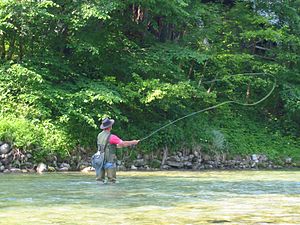
Back الصيد بالذبابة الصناعية Arabic Pesca amb mosca Catalan Muškaření Czech Fluefiskeri Danish Fliegenfischen German Pesca con mosca Spanish Euli-arrantza Basque ماهیگیری با حشره مصنوعی Persian Perhokalastus Finnish Pêche à la mouche French

Fly fishing is an angling technique that uses an ultra-lightweight lure called an artificial fly, which typically mimics small invertebrates such as flying and aquatic insects to attract and catch fish. Because the mass of the fly lure is insufficient to overcome air resistance, it cannot be launched far using conventional gears and techniques, so specialized tackles are used instead and the casting techniques are significantly different from other forms of angling. It is also very common for the angler to wear waders, carry a hand net, and stand in the water when fishing.
Fly fishing primarily targets predatory fish that have significant amount of very small-sized prey in their diet, and can be done in fresh or saltwater. North Americans usually distinguish freshwater fishing between cold-water species (trout, salmon) and warm-water species (notably black bass). In Britain, where natural water temperatures vary less, the distinction is between game fishing for trout and salmon versus coarse fishing for other species. Techniques for fly fishing differ with habitat (lakes and ponds, small streams, large rivers, bays and estuaries, and open ocean.)